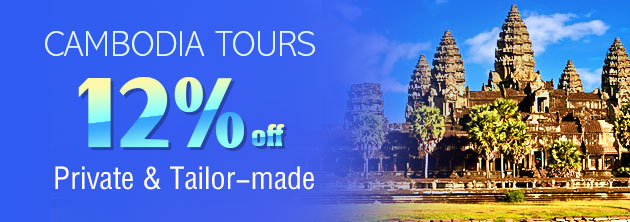Terrace of the Leper King
Terrace of the Leper King, a must-see in Angkor Thom, is surprising to immerse yourself in the aura of ancient Angkor. The terrace and the stories surrounding continue to intrigue explorers, archaeologists, and conservators to this day.The terrace is a part of the vast Angkor Thom complex, which was built towards the end of the 12th century by the then-ruler of the Angkor Empire, King Jayavarman VII. In this page, we will take a closer look at Terrace of the Leper King.
To visit it, you have head to the place that once served as Angkor Thom’s royal square. Terrace of the Leper King is located in the north-western section of the square.
When Was It Built?
Terrace of the Leper King was built under the rule of King Jayavarman VII, who commissioned the terrace’s construction shortly after the city of Angkor Thom was established as the Angkor Empire’s seat of power.How did the Terrace get its Modern-Day Name?
According to archaeologists, the terrace did not have any name originally and was simply constructed as a part of Angkor Thom’s royal square. However, when the interest in the ancient city of Angkor revitalized, a seated statue was found in the terrace. As Angkor was abandoned many hundreds years ago, the statue had been overtaken by the mossy overgrowth, which made it look like a person suffering from leprosy.According to local legends, the ancient Khmer ruler Yasovarman I had leprosy, who many people think was the inspiration behind the statue. That’s how the terrace came to be known as Terrace of the Leper King and the name stuck, even though the seated statue was moved to the National Museum of Cambodia’s capital city, Phnom Penh.
Even though the terrace still has a statue, it is only an imitation of the original, installed as a part of the restoration works conducted by conservators to restore the terrace to its former glory.
What Did the Seated Statue Represent?
The seated statue that was discovered at the site of the terrace raised questions that archaeologists and historians had a very hard time answering, as there was very little information to tell why exactly the statue was built.Several historians have claimed that the seated statue was a representation of the God of Death in Hindu mythology, Yama. Because when explorers from the west stumbled on to the statue in the 20th century, they found that the word Dharmaraja etched on the statue’s bottom half. Suggestions have been made that Terrace of the Leper King actually used to serve as a royal crematorium, which witnessed funeral ceremonies for deceased members of the royal family.
According to students of ancient Angkor history, Terrace of the Leper King may have also symbolized Mount Meru, an important Himalayan peak that both Buddhists and Hindus believe to be the center of the universe.
Architectural Style of Terrace of the Leper King
From an architectural standpoint, it’s quite evident that the terrace has many similarities to the temple of Bayon, which was built under the reign of King Jayavarman VII, too.Some of the terrace’s architectural highlights are:
• The high relief sculptures that feature prominently all across the terrace include sculptures of numerous armed guardians, Nagas (multi-headed snakes) and several celestial beings, most of them are female.
• Sculptures of demons, princes, princesses, and serpents on the inner walls of Terrace of the Leper King.
• Carvings of Lord Shiva and a sword swallower on the outer walls of the terrace. There are several indications that suggest that the carvings on the terrace walls were never completed. Many of the carvings are incomplete, similar to several other Angkor temples.
Ticket Fee to Visit Terrace of the Leper King
To visit Terrace of the Leper King, you need to purchase entry tickets at the ticket counter of the Angkor Archaeological Park. Ticket prices for one-day, three-day and seven-day passes are $37, $62 and $72 respectively.Best Time to Visit the Terrace
The Angkor Archaeological Park remains open throughout the year, with visiting hours being from 9:00 AM to 6:00 PM on a daily basis.In terms of season, you should pick either the summer or monsoon seasons to visit the terrace. Winters witness great crowds, as they are the peak tourist seasons in Cambodia.
How to Reach Terrace of the Leper King?
Terrace of the Leper King is approximately 11 km (6.8 mi) from Siem Reap and around 4 km (2.5 mi) from the main Angkor Wat temple. You can hire tuk-tuks and taxis to take you to the terrace. You should reach inside half an hour. Tuk-tuk and taxi tours of Angkor Wat and other surrounding temples generally start from $15 and $25 respectively.Once you reach the entry of the main Angkor Wat temple from the Ta Prohm side, instead of entering the premises, take a left. Head straight, passing the temples of Ta Prohm and Baksei Chamkrong to reach the ancient city of Angkor Thom. Keep heading straight and Terrace of the Leper King will be on your left.
Visit Terrace of the Leper King and all the other fascinating monuments and destinations to revisit a kingdom that will be forever remembered for its contributions to architecture.
Notable Place to Visit Nearby
While Angkor Thom has its own set of ancient temples that showcase the brilliance of classical Khmer architecture, there is another terrace located just south of Terrace of the Leper King.Known as Terrace of the Elephants, this terrace features some immaculate elephant carvings.

